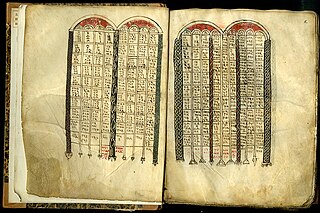Related Research Articles

Codex Tischendorfianus III – designated by siglum Λ or 039, ε 77 – is a Greek uncial manuscript of the Gospels on parchment. Palaeographically it has been assigned to the 9th or 10th century.
Family Π is a group of New Testament manuscripts, and is one of the textual families which belongs to the majority Byzantine text-type. The name of the family, "Π", is drawn from the symbol used for the manuscript known as Codex Petropolitanus. One of the most distinctive of the Byzantine sub-groups, it is the third largest and has the oldest Byzantine manuscripts belonging to it.
Family E is a textual group of the New Testament manuscripts. It belongs to the Byzantine text-type as one of its textual families, it is one of the primary early families of the Byzantine text-type. The name of the family came from the symbol of Codex Basilensis, the lead manuscript of the family, which is designated by symbol E.

Minuscule 113, ε 134 (Soden), is a Greek minuscule manuscript of the New Testament, on parchment leaves. Paleographically it has been assigned to the 11th-century.
Family Kx is a large group of the New Testament manuscripts. It belongs to the Byzantine text-type as one of the textual families of this group. It includes uncials, and although hundreds of minuscules, no early ones.
Family K1 is a small group of the New Testament manuscripts. It belongs to the Byzantine text-type as one of the textual families of this group. It has five uncials, and several early minuscules. It is one of the smallest subfamilies of the Byzantine text-type, but one of the oldest.
The Claremont Profile Method is a method for classifying ancient manuscripts of the Bible. It was elaborated by Ernest Cadman Colwell and his students. Professor Frederik Wisse attempted to establish an accurate and rapid procedure for the classification of the manuscript evidence of any ancient text with large manuscript attestation, and to present an adequate basis for the selection of balanced representatives of the whole tradition. The work of Wisse is limited only to three chapters in Luke: 1, 10, and 20.
Minuscule 578, ε 453, is a Greek minuscule manuscript of the New Testament, on paper. It is dated by a colophon to the year 1361. The manuscript has complex contents.
Minuscule 661, ε 179, is a Greek language minuscule manuscript of the New Testament, on parchment. Palaeographically it has been assigned to the 11th century. The manuscript has complex contents. Scrivener labelled it by 639e.
Minuscule 672, ε 156, is a Greek minuscule manuscript of the New Testament, on parchment. Palaeographically it has been assigned to the 11th century. The manuscript is a very lacunose. Scrivener labelled it by 618e.
Minuscule 677, ε 353, is a Greek minuscule manuscript of the New Testament, on parchment. Palaeographically it has been assigned to the 13th century. The manuscript is lacunose. Scrivener labelled it by 528e.
Minuscule 686, Θε34, is a Greek minuscule manuscript of the New Testament, on parchment. It is dated by a colophon to the year 1337. Some leaves of the manuscript were lost. Scrivener labelled it by 573e.
Minuscule 758, ε474, is a Greek minuscule manuscript of the New Testament written on parchment. Palaeographically it has been assigned to the 14th century. The manuscript has complex contents. Scrivener labelled it as 847e.
Minuscule 769, ε540, is a Greek minuscule manuscript of the New Testament written on paper. Palaeographically it has been assigned to the 14th century. The manuscript has complex contents. Scrivener labelled it as 861e.
Minuscule 776, ε1228, is a Greek minuscule manuscript of the New Testament written on parchment. Palaeographically it has been assigned to the 11th century. The manuscript has complex contents.
Minuscule 781, ε354, is a Greek minuscule manuscript of the New Testament written on paper. Palaeographically it has been assigned to the 14th century. The manuscript has no complex contents.
Minuscule 802, ε470, is a Greek minuscule manuscript of the New Testament written on paper. Palaeographically it has been assigned to the 14th century. The manuscript has no complex contents, only 24 leaves have survived.
Minuscule 1078 (in the Gregory-Aland numbering), A159 (von Soden), is a 10th-century Greek minuscule manuscript of the New Testament on parchment. It was adapted for liturgical use. The manuscript is not lacunose.
Minuscule 867, ε400, is a 14th-century Greek minuscule manuscript of the New Testament on parchment. The manuscript has no complex context, and some marginalia.
Minuscule 873, ε103, is an 11th-century Greek minuscule manuscript of the New Testament on parchment. The manuscript has survived in complete condition.
References
- ↑ H. von Soden 1902–10 Die Schriften des Neuen Testaments, in ihrer ältesten erreichbaren Textgestalt hergestellt auf Grund ihrer Textgeschichte, von Arthur Glaue, Berlin, pp. 757–65, 799–805.
- 1 2 F. Wisse, The Profile Method for the Classification and Evaluation of Manuscript Evidence, as Applied to the Continuous Greek Text of the Gospel of Luke, William B. Eerdmans Publishing, 1982, p. 92.
- ↑ David O. Voss (1938). "Is von Soden's Kr a distinct type of Text?". Journal of Biblical Literature. 57 (3): 311–18. doi:10.2307/3259821. JSTOR 3259821.
- ↑ "Family 35". Textus Receptus Bibles.
- ↑ "Translations". ByzantineText.com. Retrieved 2024-01-07.
- ↑ F. Wisse, The Profile Method for the Classification and Evaluation of Manuscript Evidence, p. 95.
- ↑ Frederik Wisse, The Profile Method for the Classification and Evaluation of Manuscript Evidence, William B. Eerdmans Publishing , 1982, p. 92, 122-125.
- ↑ F. Wisse, The Profile Method for the Classification and Evaluation of Manuscript Evidence, William B. Eerdmans Publishing , 1982, pp. 92-93.